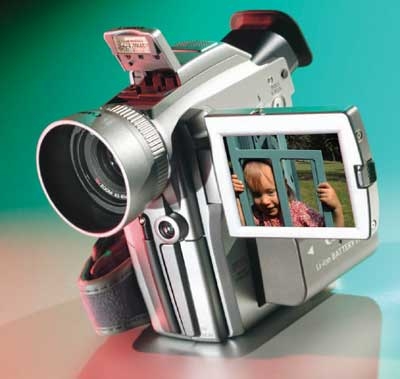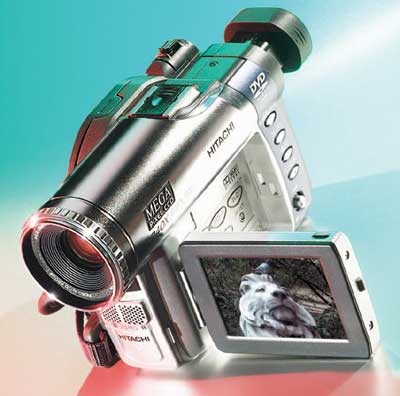A Camcorder Christmas Page 2
 | ||
|
Roll Camera With the exception of the Hitachi, which stores both video and still images on rewritable DVD-RAM and write-once DVD-R discs, all of the cameras I had in tow record on MiniDV videocassettes. Although MiniDV is an excellent format that can deliver high-quality pictures and sound, the advantages of optical media over tape will be abundantly clear to anyone who owns a DVD player.
The Hitachi gives you instant random access to the video clips and still images that you shoot, which you call up by pressing the Disc Navigation button on the camera's side panel. A grid of thumbnail pics appears on its LCD viewscreen, and you select the one you want to view by pushing the cursor control, also conveniently located on the cam's side. Of course, if you record video on DVD-R discs, you can simply finalize and remove the disc from the camera, extract it from its caddy, and then pop it into your DVD player for instant viewing on your TV. Tape-based camcorders don't offer nearly this level of instant gratification.
Format arguments aside, all the cameras featured here use similar optical and electronic components to record pictures and sound. With the exception of the JVC GR-D30, which offers an impressive 16x optical zoom, each camcorder's lens has a 10x optical zoom range. That should let you zero in on a distant scene without experiencing any of the picture degradation that's brought on by digital zooms. The Sony, Canon, Sharp, and Hitachi camcorders all feature an image sensor, or CCD (charge-coupled device, a component that converts light energy into electronic signals) with resolution of 1 megapixel or greater. Having that many pixels available may be overkill for recording video, but they come in handy if you want to snap high-res digital still images. The Samsung cam pushes this idea to its logical conclusion by actually combining two separate imaging systems in the same camera body: a MiniDV camcorder and a 4.1-megapixel digital still camera.
The seven camcorders featured here span a relatively wide range of prices, but they're all in the moderate- to budget-price category. Cams in this range almost always use a single CCD to record images. (To deliver the best possible picture quality, many high-end digital camcorders have three CCDs, each dedicated to processing either the red, green, or blue component of the video signal.) Surprisingly, however, the Panasonic PV-GS70 features a three-chip design - and at a thousand bucks, it's the first three-CCD camcorder I've seen for less than $2,000. Also, photo freaks take note: its lens is manufactured by legendary German cameramaker Leica. On the coolness scale, that's as noteworthy as the Carl Zeiss-designed lens in the Sony DCR-TRV70.
 | ||
|
On the Set All of the cams are compact and lightweight enough to grip comfortably in one hand. The easiest one to tote around, however, was the Sharp, which is tiny enough to shove into a jacket pocket. Its small size proved to be an asset during a recent family trip to a nature preserve in upstate New York. I was able to carry my daughter with one hand and pull out the Sharp at a moment's notice to record interesting sights with the other.
The tiny cam is divided into two parts: the camera itself with its lens, microphone, and LCD viewscreen, and a secondary section containing the tape compartment, the handstrap, and buttons for zoom, power on/off, and record. Both parts can be pivoted in a 270° arc, giving you loads of shooting flexibility - especially if your other hand is, well, occupied.
The Canon can also be conveniently swiveled, but only the handstrap moves, and its arc is about 45°. As with the Sharp, the vertical design of the Canon's body allows for easy one-handed operation - the other models require both mitts to control all their functions.
With their batteries attached, the Sony and Samsung proved to be the heavyweights of the crew. In the long run, the rugged, solid construction of both cams is a good thing - there's less likelihood that they'll get damaged in a high-impact scenario like a family vacation. But the Samsung in particular proved to be a beast to pull in and out of my backpack as I wandered through Central Park. I guess that's the kind of tradeoff you have to expect when a serious still camera and a camcorder are merged into one.
Each camcorder features a flip-out LCD viewscreen for monitoring images, but under some conditions - in bright sunlight, for example - you'll get a better shot by using the cam's viewfinder. With some of the models, this was easier said than done. The Canon, Sony, and Hitachi all had very clear half-inch viewfinders that could be reliably used for framing and focusing shots. On the Hitachi, however, access was hindered somewhat by a back-mounted battery that jutted out further than the viewfinder itself - a truly irritating design. The other cams all have smaller, quarter-inch viewfinders, which can make it something of a struggle to focus shots or scroll through menu items.
In situations that did need a viewscreen, all of the cameras here proved pretty satisfactory. The Samsung's LCD is a half-inch smaller than those of the other models, but with its relatively high-resolution display, I never felt I was missing anything. Each viewscreen is capable of doing a 270° turn, which lets you swivel it around to amuse kids with their onscreen likeness or view your own face when making Blair Witch-style personal video diaries.
Of all the LCDs, the Sony's and Sharp's had the best contrast in situations with high ambient light. Good thing, too, for the Sony cam: the only way you can access some of its functions is via its LCD touchscreen menu system. On a sunny day in the park, this occasionally turned out to be a hassle.
In general, plenty of control buttons and dials on the body of a camcorder are desirable - they let you quickly make changes to focus or white balance without having to scroll through menus. But it's where you put them that count. The Canon, Sony, Samsung, and Panasonic all get high-fives for the layout of their manual controls, many of which can be accessed with a quick button push. The Canon and Panasonic were particularly strong in this respect, with controls for things like manual focus, exposure compensation, and white balance located at the rear next to the record button.
If you plan to shoot only kids' birthday parties and Sunday outings, a camcorder's autofocus feature will do just fine. But if you're hoping to pull off creative, sophisticated shots, a manual focus ring can prove to be a critical tool. The Sony, Panasonic, and Canon all have one right on the camera lens. The Samsung and JVC both have an easy-to-use, though less responsive, manual focus dial on the cam's side. On the Hitachi, however, you control this function by pressing buttons located beneath the LCD viewscreen - better to stick with autofocus on this one.




























































